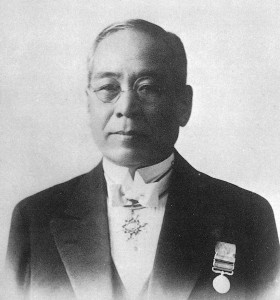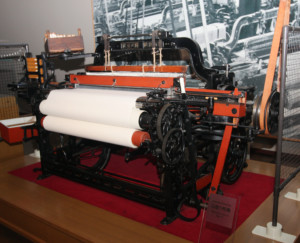
Exactly 150 years ago, on February 14, 1867, Sakichi Toyoda (豊田 佐吉 Toyoda Sakichi) was born. He is known in Japan as the King of Inventors (which is probably a bit of an exaggeration), father of the Japanese Industrial Revolution, and also the founder of the Toyota industrial empire. Time to take a look back in history on his life.
Youth

Sakichi Toyoda was born February 14, 1867, in Yamaguchi (now Kosai, Shizuoka), to Ikichi and Yui Toyoda (豊田伊吉; 豊田ゑい). His father was a carpenter and part-time farmer, and he had two younger brothers and one sister.
While the family was not rich, they were not poor either, and could afford to send young Sakichi to elementary school, which he graduated from after four years. Afterward, he started training as an carpenter.

Another significant event happened eleven days before his birth, on February 3, 1867: Emperor Meiji (明治天皇 Meiji-tennō) ascended the throne at age 14, following the surprising death of his father (poisoning is suspected). Later in the same year, the last shogun of Japan, Yoshinobu Tokugawa (徳川 慶喜), resigned.
The new emperor was now no longer a puppet of the shogun, but truly in charge. This started the Meiji restoration, which radically transformed Japan from a Middle-Aged feudal society to a modern industrial state within only a few decades. Without this, Sakichi may have spent his life as a carpenter, and Toyota may not have happened at all.
Getting Into Looms

Sakichi was inspired by a book, Saigoku risshi hen (西國立志編), the Japanese translation of Self-Help by Samuel Smiles. Smiles wrote, among other things, about inventions, including the Jacquard loom, getting young Sakichi interested into looms and significantly influencing his future career.
Hence in 1885, at age eighteen, young Sakichi changed careers. Instead of carpentry, he wanted to work with looms. He applied for a position at a weaving company, and traveled all over central Japan to learn more about looms – much to the concern of his parents. Please note that Sakichi was not the only young bright mind looking into looms. There were many others, as it was almost a boom to develop new looms. However, Sakichi turned out to be the most successful.
Patents and Companies …

Finally, in 1890, he patented his first loom (only five years after Japan established a patent law). He produced only four to five looms in his newly established factory, Toyoda Shoten. Unfortunately, while the loom had a much better productivity, it was not a commercial success, as a French patent with a different solution had the same benefit at much less cost. Additionally, his invention coincided with a recession in the weaving industry.
Hence he moved back to his hometown, where in 1893 he married his first wife, Tami (豊田たみ), from another carpentry family. In 1894, his first son Kiichiro Toyoda (豊田 喜一郎) was born. However, this marriage did not last long, and he married his second wife, Asako (豊田浅子), in 1897. This marriage resulted in a daughter, Aiko (豊田愛子), in 1899.
Over the next decades, Sakichi founded at least eight companies or factories in Japan and China, not to mention multiple partnerships. It is really hard to keep track of them all. For a good source, see Mass & Robertson below.

One company he established was the Toyoda Loom Works (in 1906 or 1907). Until then all looms were custom made and parts were not interchangeable. While in search of a solution, he met the American Charles A. Francis, who was teaching mechanical engineering in Tokyo. Francis introduced Sakichi to the American System of Manufacturing and helped him to introduce interchangeable parts. Together with numerous inventions from Sakichi, the Toyoda Loom Works soon became the largest loom producer in Japan.
In 1910, Sakichi visited Europe and the USA. Touring many weaving factories, he found the looms to be quite inferior to his own products, both in quality and in productivity. He secured his inventions through US patents.

In 1924, Sakichi – or more likely his son Kiichiro – invented the most famous product: the Model G loom. This loom was not only fully automatic, including automatic shuttle change, but stopped whenever a problem happened. For the production of this new loom, Sakichi established the Toyoda Automatic Loom Works in 1926, a direct competitor to his other company, Toyoda Loom Works. The first thousand or so looms were for testing and Toyoda’s own factories, before sales began in 1927. Even though this loom was three times more expensive, it increased productivity by a factor of ten. The product was a stellar success.
The Platt Brothers

The UK loom company Platt Brothers became interested in the patents of the Model G. In 1929 they and Toyoda agreed to a sales price of GBP 100,000 for rights to worldwide sales of the “miracle loom,” excluding Japan, China, and the USA.
Toyoda sent blueprints, looms, and an engineer to the UK to help the Platt brothers in establishing their production. Soon after the engineer returned, the Platt brothers contacted Toyoda, complained about insufficient data, and demanded a reduction in payment. Toyoda in turn pointed out low-quality manufacturing as the primary cause. After some back and forth, they agreed to a price reduction.
Succession

Toyota lore has it that Sakichi Toyoda, while on his deathbed, begged his son Kiichiro to start a new automotive company, and gave him the money from the Platt brothers.
Unfortunately, not much of this is true. The money from the Platts was spent on bonuses for the employees, and the new company was financed through traditional means. Additionally, his son Kiichiro could not take over his father’s companies due to a legal quirk: Sakichi’s daughter married Risaburo Kodama, whose relatives gave Sakichi quite a bit of money. Hence, due to social obligation, Sakichi adopted Risaburo as his own son. Adopting your adult son-in-law may sound weird to you, but in Japan such adult adoptions are still common. Hence Kiichiro was now, legally speaking, no longer the eldest son. Therefore, the Toyoda loom business went to the now-eldest son, Risaburo.
Sakichi wanted Kiichiro to establish a company too. Kiichiro was significantly influenced by Henry Ford and the American automotive boom of the 1920s, and wanted to create a car company in Japan. Hence, they established an experimental car research division at Toyoda Automatic Loom, producing cars from 1933 onward. In 1937, this company was established as an independent company, the now famous Toyoda Motor (later renamed to Toyota Motor).
However, Sakichi had little influence in that, as he died in his home on October 30, 1930, aged sixty-three, from cerebral hemorrhage and pneumonia.
Legacy

Sakichi Toyoda is known in Japan as the King of Inventors, and credited with eighty-five patents. However, most of the patents, especially the ones after 1921, were by his son Kiichiro or another group of researchers. He is credited with the famous lean method of 5 Why’s – where you repeat asking “Why?” five times to determine the root cause of the problem.
There are many inventors. There are many entrepreneurs. However, few inventors manage to bring their invention to a commercial success without third-party help. Sakichi Toyoda is such an exception, combining lifelong tinkering with looms with a strong entrepreneurial spirit.
Overall, I hope this brief history is inspiring to you. Now go out and organize your industry!
 P.S.: If you would like to read more about the history of manufacturing, then check out my book:
P.S.: If you would like to read more about the history of manufacturing, then check out my book:
Roser, Christoph, 2016. “Faster, Better, Cheaper” in the History of Manufacturing: From the Stone Age to Lean Manufacturing and Beyond, 439 pages, 1st ed. Productivity Press.
Selected Source
Mass, W., Robertson, A., 1996. From Textiles to Automobiles: Mechanical and Organizational Innovation in the Toyoda Enterprises, 1895–1933. Business and Economic History 25.

Thank you for the article. I knew some of this history but now more gaps are filled in.
Hi Jose, believe me, it was also very interesting for me to write 🙂
The Meiji “Restoration” was truly a revolution, led by a part of the nobility that took the initiative of abolishing its own privileges and changing the political system with the goal of preventing the subjugation or colonization of Japan by the European and American Great Powers of the era. Abolishing the shogunate was a revolutionary act, cleverly packaged as a restoration of the imperial power that had been usurped by Shoguns for 700 years.
The Meiji emperor didn’t rule afterwards, the revolutionaries did, and they were spectacularly successful. In a few decades, they turned Japan from a prey to the Great Powers into a Great Power in its own right, just as brutal with the rest of the world as the others. It is a unique achievement. No other country in 19th-century Asia, Africa, or Latin-America did anything like it. As such, it is worth studying closely.
Hi Michel, totally agree, the Meiji restoration was an amazing period, bringing Japan from a medieval feudal society to an industrialized society within one or two generations. I also found it amazing that they spent up to 1/3rd of the government budget on foreign experts and teachers to get up to speed in knowledge. It also was pretty much the only country in Asia that was never colonized. Very amazing indeed!
Christopher, I enjoyed this article a great deal. Thank you for posting it.
Reading between the lines, it seems that Sakichi’s adopted son, Risaburo, inherited the Toyoda Loom works, but that Kiichiro inherited the Toyoda Automatic Loom works, wherein he developed his early prototypes. Is that correct?
Hi Robert, Risaburo got the Weaving business. Sakichi started an automotive section as part of the weaving, and later got financing to found its own company, Toyota Motor.
Hello.I am from India. I want to post poem on Kichiro Toyoda to Akio Toyoda. CanIi have the mail ID of TMC – Head Quarters
Kichiro Toyoda inducted to Automotive Hall of Fame
19th July 2018, For Toyota – a memorable day it became. Its founder Kichiro Toyoda’s induction to Hall of fame came. TMC’s Chairman, President and top Management flew into city To witness the celebration of the event in honour of their celebrity.
Kichiro Toyoda inheriting the DNA of entrepreneurship from father, Designed an automation mechanism to reduce Muri for his mother. For diversifying in 1933 from the Traditional Textile Looms making Into the Automobiles field, he is known for bold decision taking
.
Seeing cars here, there and everywhere in USA, To bring such a situation in home country he paved the way. Model AA the first passenger car designed by him in 1936 rolled out. Its success gave his conviction a confidence a base – strong and stout.
Introducing innovative systems like Jit. Global headlines he could hit. For laying foundation to Toyota Production System, For revolutionizing operations, he is held in high esteem.
In 2008 Toyota could beat GM and got into position one,
What a remarkable transformation Kichiro had done!!! Model AA was show cased on the Award Function. Happy memories it brought – needless to mention.
As Toyota people rejoice over this momentous occasion, To the Toyota Team my heartiest congratulation. As a we salute the leader visionary, I say may his spirits guide Toyota to remain extraordinary.